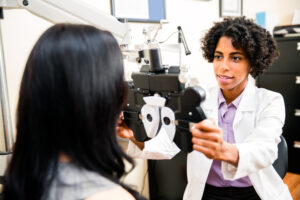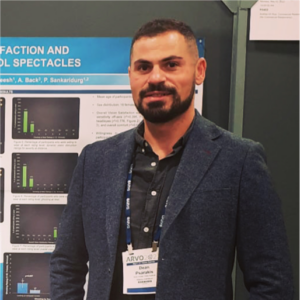June 1, 2023
By Dean Psarakis, BOptom, MSc, Senior Research Optometrist at Brien Holden Vision Institute

AMR Images, Getty Images
Axial length (AL) elongation is widely accepted as the gold standard in evaluating myopic progression in children and young adults. As clinicians, accurately relating AL elongation to the functional endpoint metric of spherical equivalent (SE) progression is essential for effectively managing our myopic patients.
The exact relationship between AL elongation and SE progression has recently become a topic of debate. The widely accepted rule-of-thumb ratio of 1mm of AL elongation corresponding to -3.00D SE progression is called into question by the authors of a recent paper by Lui et al., 2022.
Their prospective study examined 710 Chinese children aged 6-16 years at baseline and 12 months. Cycloplegic SE, AL, and corneal curvature were measured. The ratio of SE change (ΔSE) to AL change (ΔAL) (ΔSE/ΔAL) was calculated taking into consideration age and refractive status using a general linear model.
This study shows that while both ΔSE and ΔAL steadily decrease with age, the ratio of ΔSE to ΔAL ratio increases with age in myopes (2.06 D/mm in 6-year-olds, to 2.59 D/mm in 16-year-olds) and non-myopes (1.65 D/mm in 6-year-olds to 2.18 D/mm in 16-year-olds). These findings suggest that the association between AL elongation and SE progression is not a fixed relationship but is influenced by age and refractive status in children and adolescents. This knowledge can potentially improve the predictability of SE progression when using AL measures.
Abstract
Association Between Axial Length Elongation and Spherical Equivalent Progression in Chinese Children and Adolescents
Shang Liu, Xiangui He, Jingjing Wang, Linlin Du, Hui Xie, Jinliuxing Yang, Kun Liu, Haidong Zou, Xun Xu, Jun Chen
Background: It is generally believed that a 1-mm axial length (AL) elongation of the eye corresponds to a -3.00 D spherical equivalent (SE) progression, but this is disputed.
Purpose: To investigate the association between AL elongation and SE progression among children and adolescents.
Methods: A prospective cohort study of 710 children and adolescents aged 6-16 years was included. Ophthalmic examinations, including cycloplegic SE, AL, and corneal curvature, were performed at baseline and 1-year follow-up. The ratio of SE change (ΔSE) to AL change (ΔAL) (ΔSE/ΔAL) was calculated, and its association with age and refractive status was explored using a general linear model.
Results: Among all participants, 396 (55.77%) were male, with 265 (37.32%) myopes at baseline. The average 1-year ΔSE and ΔAL were 0.61 ± 0.40 D and 0.33 ± 0.22 mm, respectively. Both ΔSE and ΔAL gradually decreased with age (p < 0.001). In the general linear model analyses, age and refractive status were independently associated with ΔSE/ΔAL after adjustment for covariates (age: ˆβ = 0.04, p < 0.05; myopia vs. nonmyopia: ˆβ= 0.28, p < 0.05). Based on the developed formula ΔSE/ΔAL = 1.74 + 0.05*age (for myopes), mean ΔSE/ΔAL in myopes increased from 2.06 D/mm in the 6-year-olds to 2.59 D/mm in the 16-year-olds. In non-myopes, ΔSE/ΔAL = 1.33 + 0.05*age, and the ratio increased from 1.65 D/mm in the 6-year-olds to 2.18 D/mm in the 16-year-olds.
Conclusions: The ratio of ΔSE/ΔAL varied with age and refractive status in children and adolescents. The age-specific ΔSE/ΔAL could be used to estimate SE progression through the actual AL change.
Liu S, He X, Wang J, Du L, Xie H, Yang J, Liu K, Zou H, Xu X, Chen J. (2022). Association between axial length elongation and spherical equivalent progression in Chinese children and adolescents. Ophthalmic & Physiological Optics 42(5): 1133-1140.
DOI: https://doi.org/10.1111/opo.13023
 |
Dean Psarakis (BOptom, MSc) is a Senior Research Optometrist at the Brien Holden Vision Institute. His research areas have included myopia management and contact lenses. He has 20 years of experience in clinical practice and a passion for delivering eye care services in lower-income settings within Australia and internationally. |













